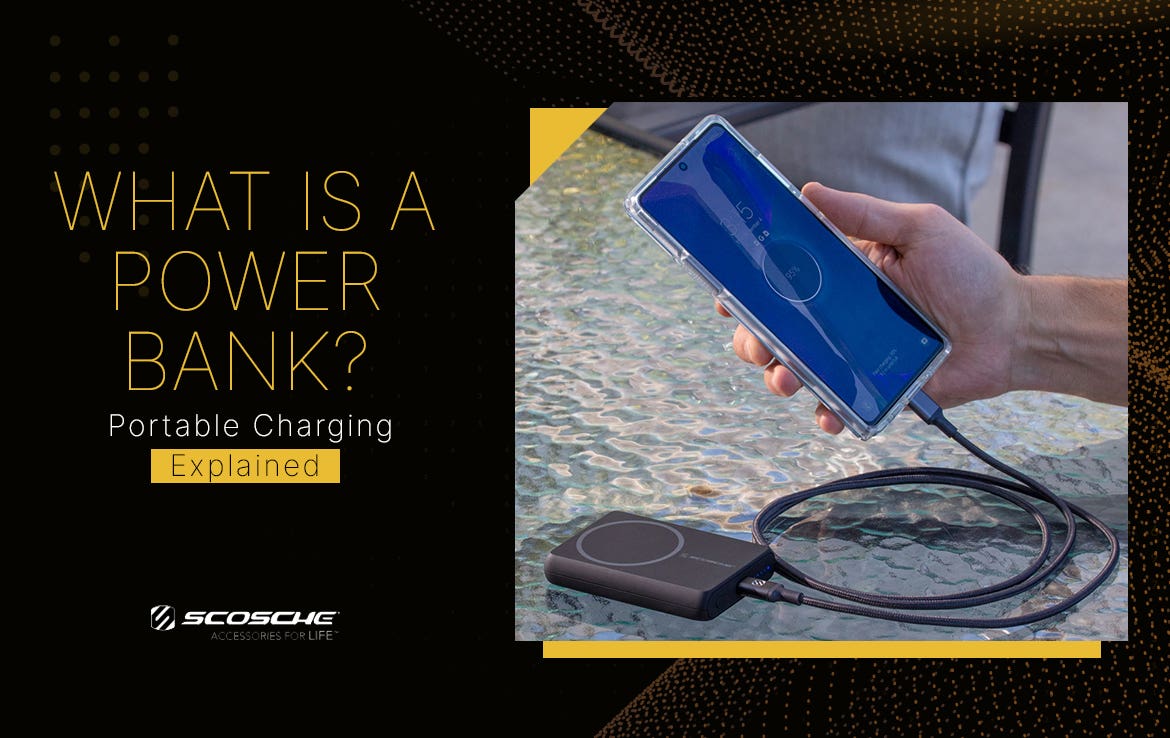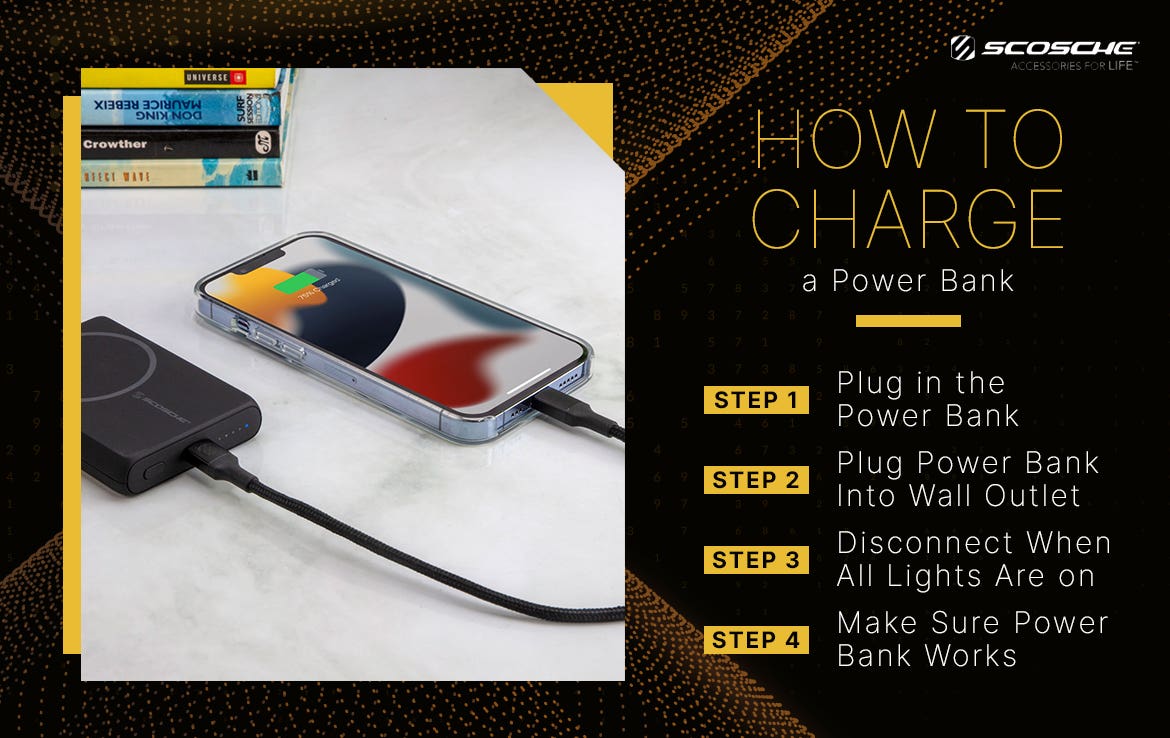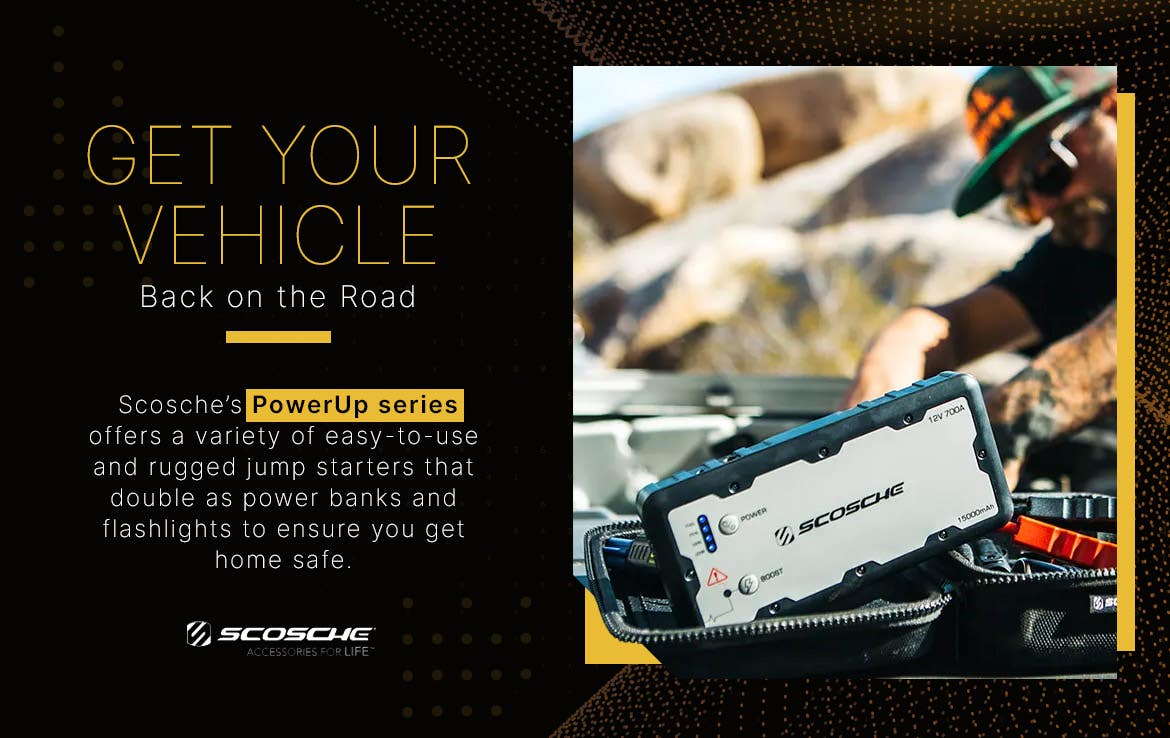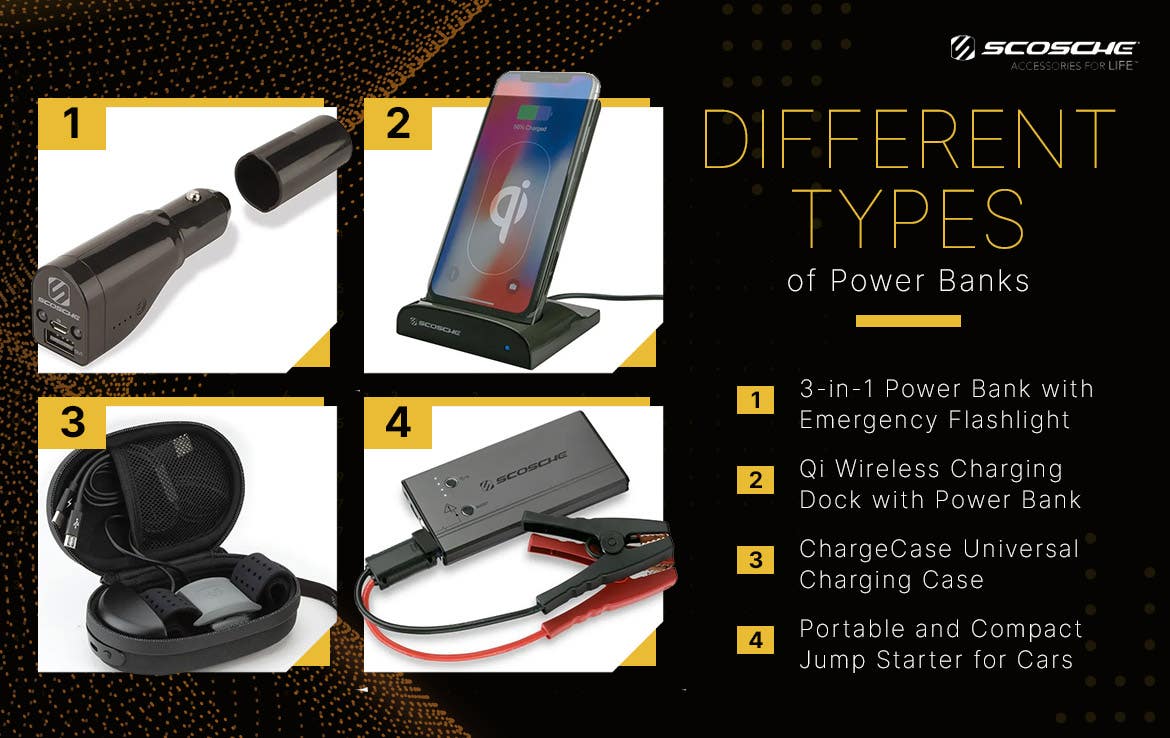What Is a Power Bank? Portable Charging Explained

What is a power bank? A power bank is basically a portable backup battery that you can carry, recharging phones and other electronic devices. They come in handy when you are without a regular wall charger or even a car charger.
Power banks come in a variety of sizes. You can get them super slim, compact and pocket-sized, making them easy to transport on a long flight or a wilderness backpacking trip. Power banks also come in much larger sizes and have a higher capacity to recharge more substantial devices like phones, tablets, cameras, wireless speakers or laptops.
So, now that you know that a power bank is a rechargeable battery that can juice up your other devices, let’s explore how they do so and some features you will find.
How a Power Bank Works
Power banks are really just regular batteries, plus a few extra features. They work just like a standard rechargeable battery. They max out their energy capacity, storing it for whenever you need it. Then, when you plug it into a device — say a phone or a DSLR camera — it releases the energy back, charging up the device.
However, inside a power bank, there is a lot of other circuitry and tech going on. A power bank offers itself up as a recharging tool. Able to charge just about anything, a power bank is a mighty convenient tool to have on hand and always there when you need it. But since it is used to charge a variety of devices, power banks are not simply charging devices. They do have some built-in safety features, functions and technologies like a power indicator and quick-charge settings.
Different Types of Power Banks


As previously mentioned, power banks come in all sorts of sizes, from compact, pocket-size banks to large, high-capacity banks. Of course, the type of power bank you choose depends a lot on your needs and budget, but rest assured, there is a powerful power bank out there suitable for your hobby, career and any device you need charging.
Many people rely on power banks to recharge a phone, smartwatch, tablet or a laptop during their travels or throughout a remote workday away from an office and outlets. However, you can also find power banks that can store enough power to recharge much larger electronics like drones, portable mini-fridges and even critical medical equipment like breathing machines, power wheelchairs and home oxygen or dialysis equipment.
Power banks are being improved upon each year, growing in capacity and becoming more compact and transportable. Today, you can even find power banks that use solar energy, harnessing the sun’s power without needing to be charged through a wall first. You can also find power banks with a protective case, securing your phone as it charges it. Whatever kind of power bank you need, there’s something for everyone.
Types of Power Banks Batteries
Power banks are offered in two different Lithium-type batteries: Lithium-Polymer (Li-Po) and Lithium-Ion (Li-Ion). However, the Li-Ion power banks are the more popular models. Here’s why:
While Lithium-Polymer batteries have a higher energy density, they typically also have a shorter lifespan. Plus, Li-Po is more expensive to manufacture. On the flipside, Li-Ion batteries have a lower energy density (albeit ever-so-slight) and can withstand more charging cycles. As a result, they are also less expensive than their Li-Po counterparts.


How to Charge a Power Bank
Now that you know what a power bank is, how do you charge it to, in turn, help charge other things? Let’s break it down:
Power banks come with a power input port, which can vary depending on the model. Some power banks come with a micro USB port, while others have a USB Type-C port. Like all our electronic devices, though, it appears that the USB Type-C port is winning the race, overtaking the once-popular micro USB port. Until the USB Type-C port is outdone by something else entirely, it looks to be the new standard for power banks and other devices. With this in mind, if you are purchasing a new power bank, look for one with a USB Type-C input port. Otherwise, you might find your power bank to be outdated rather quickly.
Charging your power bank is relatively easy. All you need is a wall charger or wall outlet. However, you want to make sure it is a wall charger that delivers a high-power output. If you plug in your power bank to a low-quality charger that only puts out 2A (two amps), you will be waiting a while for the power bank to charge fully. If you’re in a hurry, you should also avoid charging a power bank via laptop USB port, car cigarette lighter or by the sun’s rays (for those eco-friendly, solar-powered chargers). While it’s entirely possible to charge a power bank this way and often convenient, you could be waiting several hours.
So do yourself a favor and charge your power bank directly from a wall outlet. Alternatively, you could also use a charging station that supports multiple devices.


Charging Steps
Step One: Plug in the Power Bank
Your power bank will have LED lights on the side that will indicate when it needs charging. Most power banks have four LED lights, which shut off when the battery is depleted. However, as a general rule, only charge your power bank when only one or two lights are on. Otherwise, you could overcharge it and shorten the power bank’s lifespan.
Step Two: Plug the Power Bank Into a Wall Outlet
Using the USB cord and adapter your power bank came with, plug it into a wall outlet and leave it to charge. How long will it take to charge fully? That depends a lot on the make and model. To find out, check the instructions for an estimated charging time. Again, this is important to know or you could overcharge your power bank, shortening the life.
Step Three: Disconnect When All LED Lights Are on
While it’s plugged in, check the power bank periodically to avoid overcharging. You will know when the power bank is fully charged when all the LED lights are on and, on some devices, when the lights have stopped blinking. Now, unplug the charger and, just to double-check, make sure the power bank is working correctly.
Step Four: Make Sure the Power Bank Works Efficiently
Unplug the power bank and connect one of your electronic devices to verify that the power bank is charged. Connect the device using the USB cord and make sure it’s charging properly and efficiently. If the power bank didn’t charge, try a different outlet. If it still doesn’t charge, it may be a sign it’s broken and needs the manufacturer’s help.
Extra Tip: Charge your electronic devices and power banks at the same time. While the power bank charges, also charge other devices to ensure they have all the boost they need. Having a power bank for backup power is super convenient, but charging does drain the battery significantly more than charging directly into a wall. Having your devices fully charged also maintains the power bank’s overall battery life.
Discover the Best Portable Chargers
How Long Power Banks Take to Charge
Okay, so you might be wondering how long power banks take to charge fully. This depends on many factors, but primarily due to the capacity size of your power bank. Obviously, the more energy and power the power bank can hold, the longer it will take to charge up. However, there are other factors, such as the charging technology used.
If you need a fast-charging power bank, look for power banks that have the new graphene or GaN technology. These charge much faster than their predecessors and will have you powered up in no time.
However, you can expect the average power bank to charge in two to four hours. For a power bank with 10,000mAh, it will charge in four to six hours. The best power banks with GaN tech can charge in under one hour.
Why You Should Have a Power Bank
A power bank charger can come in handy for a multitude of reasons. Not convinced? Even if you have a good habit of recharging your devices before setting out for the day, we’re certain a power bank can prove helpful. No matter the kind of lifestyle you lead or the career you have, here are just a few ways power banks can save the day.


Get You Back on the Road
Did you know you can use a power bank to recharge a dead car battery? Yep, there’s a car jump starter large enough to get your vehicle back on the road in emergencies. Scosche’s PowerUp series offers a variety of easy-to-use and rugged jump starters that double as power banks and flashlights to ensure you get home safe.
With a dead car and dead phone, you can charge up to call for help while jump-starting your car to get back on the road. Perfect for cars, trucks and even motorcycles, each Lithium-Ion battery can last months on a single charge. Plus, each PowerUp model offers an ultra-bright LED flashlight, which can be used to find your way beneath the car’s hood at night or to alert passing vehicles for help in an emergency.
Staying Connected Along the Journey
Another great way a power bank comes in handy? To help you stay connected to family and friends during your travels. Whether you’re taking a long, cross-country road trip by car or skipping across the pond by plane, a spare power bank can keep your electronic devices charged at all times, even when you have little access to a wall charger at the airport or bus station.
Luckily, you can find a high-quality, top-performing phone charger and backup battery that is small and compact enough to stuff into carry-on luggage or in a pocket wherever you may go. Check out Scosche’s extensive selection of phone chargers and backup batteries for the home, office and beyond. Plus, as long as the battery is 100 Wh or under, you can take them onboard flights. And with 160 Wh and under, all you need is a special permit.
Completing the Next Level
If you’re a big gamer, a power bank is a must! With power-hungry consoles like the Nintendo Switch, your device will drain in no time. But with a backup power bank, you can stay in the game and finish that next level without missing a beat. Even when playing simple online games with your phone, the video playback can kill your phone quickly. So instead of bored teenagers or gamers, a power bank can occupy for hours.
Staying Safe in the Outdoors
Camping or hiking in the wilderness requires a certain amount of skill. But even the most skilled outdoors person needs help from time to time. It’s always a good idea to bring a phone when you get outside. Even if you prefer to be unplugged while enjoying nature, a power bank can keep you connected should you ever need it.


However, a power bank can also offer assistance, too. For example, it can keep your wireless speakers playing music on the beach, but it can also charge your drone or handheld GPS. If you plan to use a power bank outdoors, make sure it can withstand the elements and is entirely snowproof, waterproof and dustproof. Overall, the construction and materials should be pretty rugged.
For Festivals
While a very thoughtful amenity, festivals will not always have charging stations. And with a sprawling festival with tons to do and see, the last place you want to be is at a charging dock trying to give your phone a boost. A power bank can also offer help with this common problem at all kinds of festivals, whether you’re a visitor or managing a booth. Keep your phone charged to continue using a credit card reader so that you can continue to make sales. Or simply keep your phone or camera charged so you can capture the day, taking snapshots and sharing on social media. It can also allow you to track fellow friends and plan when to meet up where.
Staying Connected on the Job or in Class
Portable power banks can help with your career. You may have the kind of job that requires you to be on your electronic devices all day long. Whether you are a real estate agent who drives clients all over town or a salesperson who does an enormous amount of travel, having phones and other devices juiced up at all times is imperative. Even photographers who are out on a shoot for a wedding or commercial project need to keep their cameras powered up. And the list goes on. So whatever kind of job you have, a power bank is sure to come in handy.
Students can also use power banks to stay connected. Jumping from one class lecture to the next where you’re required to take notes on a laptop or tablet device, it’s good to have a power bank to keep everything charged.


Check Out Scosche’s Power Banks
Hopefully, this breakdown helps you to understand power banks. Learning how to use your power bank properly can help maintain its lifespan and charge your devices correctly. And everyone can use a power bank. They are a useful and practical tool to have on hand.
Explore Scosche’s power banks and portable charging devices. You never know when you might need one!
Image Sources
Nor Gal/Shutterstock.com
VADISH ZAINER/Shutterstock.com
Olga Hmelevskaya/Shutterstock.com